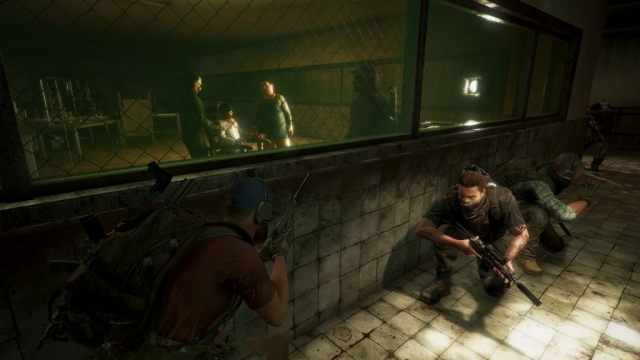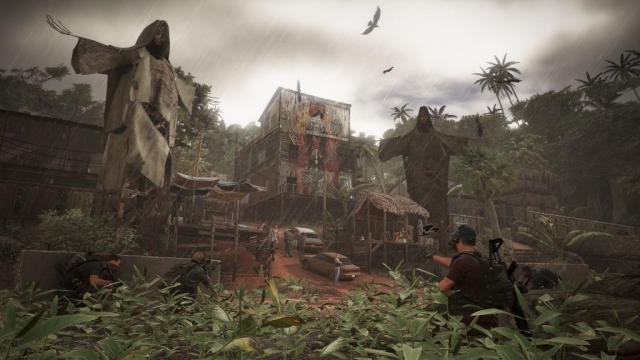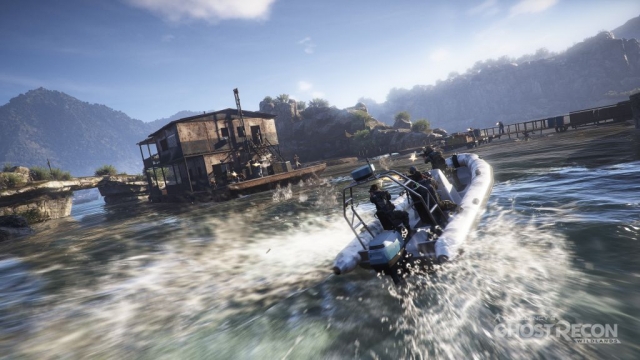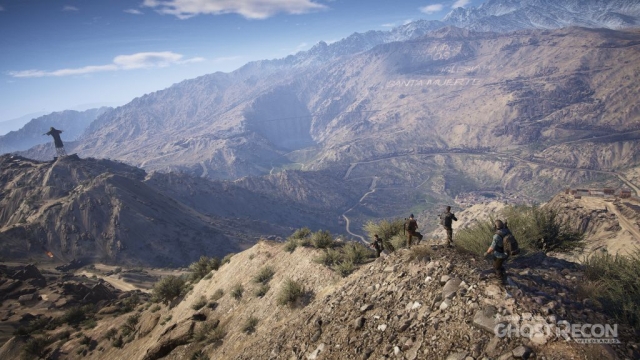Tom Clancy’s Ghost Recon: Wildlands
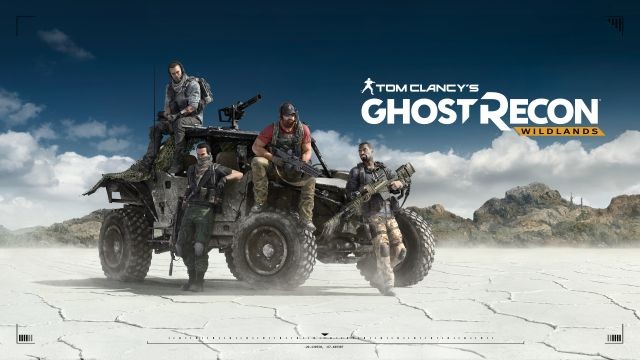
Listen up Ghosts. The Santa Blanca, a previously minor Mexican drug cartel, has overtaken Bolivia to the point where the country has become a narco-state. Powerless against the radio-blaring, Lamborghini-loving sicarios, the Bolivian government has made a truce with the cartel: leave our civilians alone and we’ll look the other way. But Santa Blanca’s influence has begun to spread beyond Bolivia, and when a crude bomb targets the U.S. embassy in La Paz and undercover DEA agent Ricardo Sandoval is found dead – tortured and killed by Santa Blanca – the U.S. government initiates Operation Kingslayer, a joint movement between the CIA, DEA and JSOC aimed at taking down the highest-ranking members of the cartel leading up to its boss, El Sueño. Kill the head of the snake and the body will die. This is Tom Clancy’s Ghost Recon: Wildlands.
I’ve been a fan of most Tom Clancy-branded video games ever since I played the original Ghost Recon on the Xbox in 2002. Back then Ghost Recon was neither open world nor viewed from a third-person perspective, but I can envision the missions from that initial Ghost Recon title existing within a singular map, and so the free-roaming evolution seems like it would be a natural fit for the series. Ubisoft has had a love affair with open worlds for some time now and why not, they’ve become master world builders; even their recent extreme sports game, Steep, was open world. At 400km², Wildlands is Ubisoft’s biggest sandbox yet. Bolivia’s diverse ecosystems have been expertly recreated, from the snow-capped mountains and Amazonian forests, to the flooded wetlands and world’s largest salt flat. The result is a truly enormous and beautiful world, but its sheer size is also the source of the game’s most pressing issues. Let’s start from the beginning, shall we?
The first thing you’ll do in Wildlands is create your character. In addition to choosing your gender, you’ll customize your head and facial details, as well as your general appearance; body details (facial paint and tattoos), clothes (tops, pants, vests and footwear), and accessories (eyewear, headwear, handwear, backpacks, etc.). While the customization options are numerous, they’re purely cosmetic. Wearing proper camo or a guillie suit doesn’t make you less detectable; sporting a tactical vest doesn’t reduce or stop penetration of projectiles and shrapnel; and dressing down in a t-shirt and cargo pants doesn’t make you more agile. These types of traits are handled through the game’s skill system.
If you assume that being able to fully customize your character means you’re not at the center of the plot, you’d be correct in this instance. You’re the straw that stirs the drink, but Wildlands is a tale of revenge as your lead contact, CIA officer Karen Bowman, clearly has it out for El Sueño and his organization following the death of her friend, Ricky Sandoval. The setup is solid, but the open-ended nature of the campaign – you can tackle the missions in any order you choose – leads to a narrative that is more a generalization of Santa Blanca’s stranglehold on Bolivia. The story lacks focus beyond the prologue and doesn’t take enough advantage of some of the cartel’s more villainous members.
Let’s talk campaign structure. The Bolivian map is broken up into 21 provinces, each controlled by a buchon who is associated with a cartel lieutenant, who themselves answer to an operation head; be it smuggling, production, influence or security. As soon as you enter a new province, Bowman will brief you on the buchon controlling the region, and you’ll begin to explore the province for intel. Gathering intel unlocks story missions and reveals side missions and other content, including weapon and accessory cases, evidence files, and cartel medals that reward players with skill points and skill boosts.
There are a handful of different side missions that help curry favor with a local rebel faction or reward you with resources necessary for progression. This brings us to the skills system. As you progress through the campaign you’ll gain XP, level up and earn skill points. You can spend skill points to unlock new skills or incrementally improve existing ones. Some skills are incredibly useful, such as removing damage reduction of suppressors or adding thermal vision to your drone, while others seem tacked on. For instance, bullet resistance is an acquirable skill when it should really be tied to the type of vest you’re wearing, or not wearing. And why do I need food in addition to the requisite skill points in order to increase the amount of C4 that I can carry? Am I trading resources with the rebels for additional C4? If so, how is it that I can re-supply my C4 at any ammo box within Bolivia, but only after I acquire the C4 skill? Some of the systems in place don’t make a lot of sense; they seem to exist just to give players something else to do in this massive sandbox. Problem is, once you’ve stolen one plane, you’ve stolen them all. There’s simply not enough variety within the resource-acquiring side missions to tie them to progression.
The story missions also suffer from repetition, though not as much. In order to capture or kill a buchon, you first have to complete a handful of missions in order to draw them out. These story missions generally fall into one of a half-dozen scenarios: trail a target, extract a target, kill a target, steal an objective, blow up an objective, and defend an objective. Once you’ve dealt with the local buchon, it’s off to the next region. Take down enough buchones and you’ll draw out their lieutenant. Capture and/or kill the lieutenant and all of their respective buchones, and the operation head will reveal themselves. There are 21 provinces, 18 controlled by a buchon, and though you don’t have to deal with every buchon, lieutenant and operation head in order to get El Sueño’s attention, I’m sure you get the picture. While the initial hours of Wildlands are fresh and exciting, it isn’t too long into the 40’ish hour campaign before repetition starts to set in as you undertake the same side missions and story scenarios over and over. The locations change, wonderfully so, but the process remains the same.
For this reason, your enjoyment of Wildlands may hinge on whether you have friends to play with. With seamless drop in, drop out co-op for up to four players throughout the entirety of the campaign, assembling a squad of friends or like-minded players and taking down the Santa Blanca together is a lot more fun (the game constantly asks if you’d like to join or launch a multiplayer lobby; I think even it knows). Pulling off a sync shot is a lot more challenging – though even more rewarding – and I’m not sure why each player has to tag their own resources, but there’s nothing like planning and executing a successful mission as a team, or sharing in the moment when your best laid plans go awry.
If you’re playing solo, the game will partner you with three AI-controlled squadmates. So long as you remain undetected, not only will your squadmates intrinsically call out enemy locations and provide other useful intel, they’re impeccable sharpshooters. Tagging up to three enemies, you can order your squad to carry out a sync shot that eliminates each of the targets at once. It’s ridiculously effective…and glitchy. Your squadmates can execute sync shots through solid objects, including concrete and sheer rock. They’ll let you know if they have line of sight, but they don’t always need line of sight to take down their target. Sync shots are a source of some of the game’s most gratifying moments, but they can equally cheapen the experience regardless of intention.
As impressively as your AI squadmates perform while concealed – as well as while engaged in vehicular combat – once detected they’re next to incompetent. The virtual nerves must set in; they don’t take initiative, they’re not aggressive, and most troubling they often ceasefire. It’s like they’re waiting for your next order, only that can be difficult to give once the lead starts to fly. I can’t tell you how many times I was downed, only to watch one of my fellow Ghosts revive me without first taking down the enemy still standing next to me. Enemy AI is equally hit-and-miss. The UNIDAD soldiers are far more difficult than the Santa Blanca, but for a tactical shooter they’re all lacking in tactics. The enemy rarely flanks you or uses explosives to their advantage. Often the game will try to overwhelm you with sheer numbers as the enemy calls for reinforcements, but in smaller groups they’re not much of a threat. I recommend ramping up the difficult setting and/or turning off elements of the minimap to make combat more challenging.
Speaking of combat, the free form mission design is one of Wildlands’ strong suits. The game encourages you to play your missions your way. For instance, you can choose to infiltrate an enemy base quietly during the night or loudly during the day. You can choose to destroy floodlights and generators to create darkness and incite panic, disable alarms so the enemy can’t call for reinforcements, turn off jammers so you can use your drone to scout the location, or blow up mortar installations to impair their defenses. You can choose to release imprisoned rebels to create a distraction or request rebel support in the form of mortar strikes or soldiers to fight alongside. You can choose to snipe from afar, arm yourself with a shotgun and get up close and personal, or something in-between. You can choose to set traps and lure your enemies to an unexpected death. You can choose to commandeer an enemy vehicle to gain access under disguise. You can even choose to throw up your drone and command your squad to do all the work for you. It’s all about choice, and it’s when these systems and others (civilian presence, multiple factions, etc.) overlap – causing friction and chaos – that combat truly excels.
Considering they play a substantial role in Wildlands – mostly to get from point A to point B in this massive world, but also in combat – vehicle handling is far too loose. Cars handle like they don’t have tire grips, sliding at the slightest turn yet able to drive at absurd angles. Helicopters take some getting used to, but quickly become the de facto way to get around the map; I just wish it were easier to use their weaponry. Arguably the best choice for off-road adventuring, motorcycles are virtually indestructible, smashing through cement barricades and clipping through vegetation without slowing down. The sketchy vehicle physics are equally frustrating and comically fun, but I eventually ditched them in the later stages of the campaign in favor of fast travel. At least the damage model is impressive.
As I stated earlier, Bolivia has been beautifully realized and is brimming with diverse ecosystems to discover and explore. The massive open world isn’t without faults; texture pop in is present, especially when flying over the environments, and clipping is prevalent when using ground-based vehicles. There are other oddities, such as the nearly indestructible chain-link fences, but overall I was really impressed with the visuals. It’s the little touches – how mud collects at the base of your vehicle as you drive along dirt paths; how the roads stay wet and slick in the moments following a rainfall, and how beams of sun break through the clouds shortly thereafter; or how your character carefully treads downhill. The attention to detail is simply astounding considering the vastness of the open world.
Sound design is equally stellar, though it too suffers from the odd issue. The radio is sure to be a point of contention among players. If there’s one thing the Santa Blanca love more than driving a Lamborghini, it’s listening to the radio. In every village, every coca field, even the most remote locations of Bolivia, you’re sure to hear a radio blaring DJ Perico, host of the only radio station in town; which makes sense considering the cartel uses it for propaganda purposes, it just means you’ll listen to the same promos and tunes over and over. Having said that, I very much appreciate how the broadcast is constantly being updated with news of your exploits, even if the stories are being twisted in Santa Blanca’s favor. The big issue I have with the radio is how often it drowns out important dialogue and ambient sounds (a recent patch has since allowed players to turn the radio off altogether). Whether your fellow Ghosts are calling out enemy positions in thoughtful detail or simply telling a joke while traveling from location to location, I immensely enjoyed the squad chatter. The only knock is the playful banter occasionally bled into enemy engagements, which is distracting to say the least. On the flipside, an impromptu firefight once interrupted a radio communiqué I was having with Bowman, and when the gunfire ceased, the interaction picked back up with her saying, “I thought I had lost you there for a moment”. Brilliant stuff.
Wildlands is the first Ghost Recon installment not to offer a competitive multiplayer component at launch. Ubisoft has stated that PvP is coming as part of a free post-launch update, describing it as 4×4 team combat. While that doesn’t sound like the usual Ghost Recon competitive multiplayer, Wildlands isn’t your typical Ghost Recon experience so I’ll reserve judgment until I’m able to try it out.
It seems crazy to say this, but Tom Clancy’s Ghost Recon: Wildlands is a little too big for its own good. It’s hard not to admire the time and effort that went into crafting this truly massive and beautiful open world, but there’s simply too much copy and paste going on when it comes to the content within; the side missions especially, but also the story scenarios. While the initial hours of Wildlands are thrilling, repetition ultimately seeps in and as such you’re enjoyment of the game may depend on whether you have a friend or three to play through the campaign with. Ubisoft has done a tremendous job supporting a pair of other recent Tom Clancy titles post-launch – Rainbow Six: Siege and The Division – so even if you’re not sold on Wildlands as it stands, I highly recommend keeping your sights trained on the game as the developers tweak the experience and eventually add the competitive multiplayer suite.
Reviewed By: Stephen Riach
Publisher: Ubisoft
Rating: 75%
——————————————————————————–
This review is based on a digital copy of Tom Clancy’s Ghost Recon: Wildlands for the Xbox One provided by Ubisoft.
 Game Over Online
Game Over Online